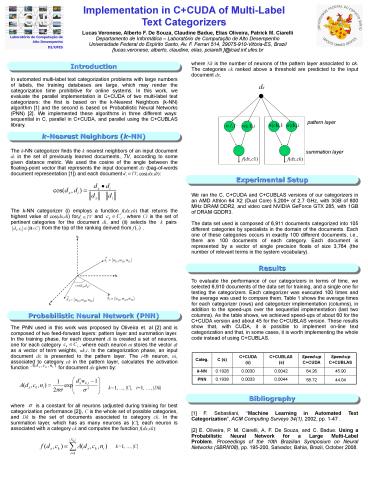Implementation in C CUDA of Multi-Label Text Categorizers - PowerPoint PPT Presentation
Title:
Implementation in C CUDA of Multi-Label Text Categorizers
Description:
Implementation in C+CUDA of Multi-Label Text Categorizers Lucas Veronese, Alberto F. De Souza, Claudine Badue, Elias Oliveira, Patrick M. Ciarelli – PowerPoint PPT presentation
Number of Views:61
Avg rating:3.0/5.0
Title: Implementation in C CUDA of Multi-Label Text Categorizers
1
Implementation in CCUDA of Multi-Label Text
Categorizers
Lucas Veronese, Alberto F. De Souza, Claudine
Badue, Elias Oliveira, Patrick M.
Ciarelli Departamento de Informática
Laboratório de Computação de Alto
Desempenho Universidade Federal do Espírito
Santo, Av. F. Ferrari 514, 29075-910-Vitória-ES,
Brazil lucas.veronese, alberto, claudine, elias,
pciarelli _at_lcad.inf.ufes.br
where Nk is the number of neurons of the pattern
layer associated to ck. The categories ck ranked
above a threshold are predicted to the input
document dx.
Introduction
In automated multi-label text categorization
problems with large numbers of labels, the
training databases are large, which may render
the categorization time prohibitive for online
systems. In this work, we evaluate the parallel
implementation in CCUDA of two multi-label text
categorizers the first is based on the k-Nearest
Neighbors (k-NN) algorithm 1 and the second is
based on Probabilistic Neural Networks (PNN) 2.
We implemented these algorithms in three
different ways sequential in C, parallel in
CCUDA, and parallel using the CCUBLAS library.
dx
pattern layer
wck,1
wck,i
w1,1
wc1,i
k-Nearest Neighbors (k-NN)
The k-NN categorizer finds the k nearest
neighbors of an input document dx in the set of
previously learned documents, TV, according to
some given distance metric. We used the cosine of
the angle between the floating-point vector that
represents the input document dx (bag-of-words
document representation 1) and each document
, cos(dx,di)
summation layer
f(dx,c1)
f(dx,ck)
Experimental Setup
We ran the C, CCUDA and CCUBLAS versions of our
categorizers in an AMD Athlon 64 X2 (Dual Core)
5,200 of 2.7 GHz, with 3GB of 800 MHz DRAM DDR2,
and video card NVIDIA GeForce GTX 285, with 1GB
of DRAM GDDR3. The data set used is composed of
6,911 documents categorized into 105 different
categories by specialists in the domain of the
documents. Each one of these categories occurs in
exactly 100 different documents, i.e., there are
100 documents of each category. Each document is
represented by a vector of single precision
floats of size 3,764 (the number of relevant
terms in the system vocabulary).
The k-NN categorizer (i) employs a function
f(dx,ck) that returns the highest value of
cos(dx,di) for and , where Ci is
the set of pertinent categories for the
document di, and (ii) selects the k pairs
from
the top of the ranking derived from .
Results
To evaluate the performance of our categorizers
in terms of time, we selected 6,910 documents of
the data set for training, and a single one for
testing the categorizers. Each categorizer was
executed 100 times and the average was used to
compare them. Table 1 shows the average times for
each categorizer (rows) and categorizer
implementation (columns), in addition to the
speed-ups over the sequential implementation
(last two columns). As the table shows, we
achieved speed-ups of about 60 for the CCUDA
version and about 45 for the CCUBLAS version.
These results show that, with CUDA, it is
possible to implement on-line text categorization
and that, in some cases, it is worth implementing
the whole code instead of using CCUBLAS.
Probabilistic Neural Network (PNN)
The PNN used in this work was proposed by
Oliveira et. al 2 and is composed of two
feed-forward layers pattern layer and summation
layer. In the training phase, for each document
di is created a set of neurons, one for each
category , where each neuron ni stores
the vector di as a vector of term weights, wk,i.
In the categorization phase, an input document dx
is presented to the pattern layer. The i-th
neuron, ni, associated to category ck in the
pattern layer, calculates the activation function
for document dx given by
Categ. C (s) CCUDA (s) CCUBLAS (s) Speed-up CCUDA Speed-up CCUBLAS
k-NN 0.1928 0.0030 0.0042 64.26 45.90
PNN 0.1938 0.0033 0.0044 58.72 44.04
k1, ..., C, i1, , Dk
Bibliography
where is a constant for all neurons
(adjusted during training for best categorization
performance 2), C is the whole set of possible
categories, and Dk is the set of documents
associated to category ck. In the summation
layer, which has as many neurons as C, each
neuron is associated with a category ck and
computes the function f(dx,ck)
1 F. Sebastiani, Machine Learning in Automated
Text Categorization, ACM Computing Surveys
34(1), 2002, pp. 1-47 . 2 E. Oliveira, P. M.
Ciarelli, A. F. De Souza, and C. Badue. Using a
Probabilistic Neural Network for a Large
Multi-Label Problem. Proceedings of the 10th
Brazilian Symposium on Neural Networks (SBRN'08),
pp. 195-200, Salvador, Bahia, Brazil, October
2008.
k1, ..., C































